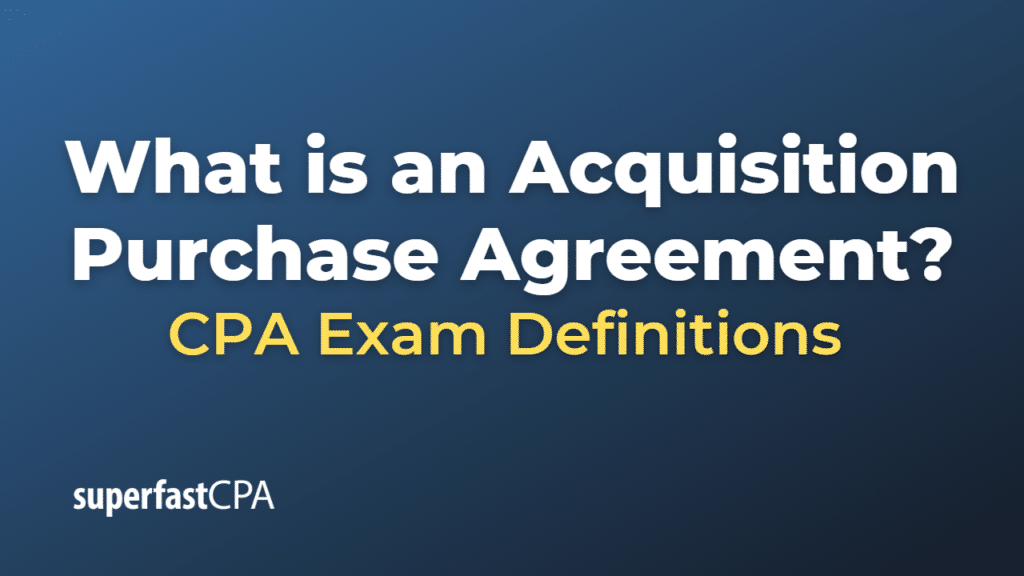Acquisition Purchase Agreement
An acquisition purchase agreement, also known as an asset purchase agreement or share purchase agreement, is a legal document that outlines the terms and conditions under which a buyer acquires the assets, shares, or business of a target company. The agreement is typically negotiated between the buyer and seller during the acquisition process and includes specific details about the transaction, such as purchase price, payment terms, closing conditions, representations and warranties, indemnification provisions, and other relevant terms.
Key components of an acquisition purchase agreement may include:
- Purchase price: The agreed-upon price the buyer will pay for the assets or shares of the target company.
- Payment terms: The terms under which the buyer will pay the purchase price, such as cash at closing, deferred payments, or a combination of cash and stock.
- Assets or shares included: A detailed list of the assets or shares being acquired, including tangible assets (e.g., equipment, inventory, real estate) and intangible assets (e.g., intellectual property, customer lists, contracts).
- Excluded assets or liabilities: Any assets or liabilities that are specifically excluded from the transaction and will not be transferred to the buyer.
- Representations and warranties: Statements made by both the buyer and seller regarding the accuracy of information, the condition of assets, and the financial and operational health of the target company.
- Closing conditions: Conditions that must be met before the transaction can be finalized, such as obtaining regulatory approvals, shareholder approvals, or third-party consents.
- Indemnification provisions: Provisions outlining the obligations of the buyer and seller to indemnify each other for losses resulting from breaches of representations, warranties, or covenants in the agreement.
- Non-compete and non-solicitation clauses: Provisions restricting the seller from engaging in competing businesses or soliciting employees or customers of the acquired business for a specified period after closing.
- Termination clauses: Conditions under which either party can terminate the agreement, such as a failure to meet closing conditions or a material breach of the agreement.
An acquisition purchase agreement is a critical document in the acquisition process, as it defines the rights and obligations of both parties and serves as the basis for resolving disputes that may arise during or after the transaction.
Example of an Acquisition Purchase Agreement
Let’s consider a hypothetical example of an acquisition purchase agreement:
Company A, a large tech company, is planning to acquire Company B, a smaller software development firm, to expand its product offerings and increase its market share. Company A and Company B negotiate the terms of the acquisition and enter into an acquisition purchase agreement that includes the following key terms:
- Purchase price: Company A agrees to pay $50 million for the acquisition of Company B.
- Payment terms: Company A will pay $40 million in cash at closing and the remaining $10 million through a promissory note, payable over three years.
- Assets included: The acquisition includes all of Company B’s tangible assets (e.g., office equipment, computers, and software licenses) and intangible assets (e.g., intellectual property rights, customer contracts, and trade secrets).
- Excluded assets: Company B’s founders will retain their personal laptops and other personal belongings.
- Representations and warranties: Both parties make various representations and warranties, including Company B’s representation that its financial statements are accurate, and Company A’s representation that it has the necessary funds to complete the transaction.
- Closing conditions: The closing of the transaction is subject to the approval of Company B’s shareholders and the receipt of necessary regulatory approvals.
- Indemnification provisions: Both parties agree to indemnify each other for any losses arising from breaches of their respective representations, warranties, or covenants.
- Non-compete and non-solicitation clauses: Company B’s founders agree not to compete with the business or solicit its employees or customers for a period of two years following the closing of the transaction.
- Termination clauses: The agreement may be terminated by either party if the closing conditions are not met within six months from the date of the agreement, or if there is a material breach of the agreement by the other party.
In this example, the acquisition purchase agreement sets forth the terms and conditions under which Company A will acquire Company B and outlines the rights and obligations of both parties during and after the transaction.













